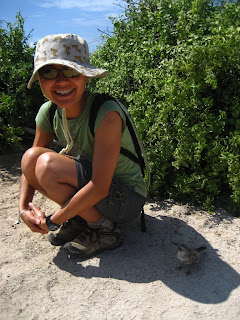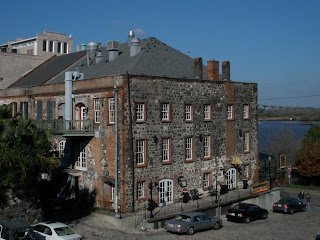
Eva is a little girl in Georgia who never allows herself to be bored. One early spring morning she is sitting on the river bank, enjoying the sunshine and playing Sudoku. Suddenly a monkey jumps in front of her and then disappears into the river. She gets into her little kayak and follows the monkey into the narrow tidal creek that has tall marsh grass standing on both sides and feels like going down a rabbit hole. At the end of the creek, the water empties into a broad river as wide as the sea. Across the choppy river with swells twice as high as her little kayak lies an island of lush forest, and beyond that, the big open Atlantic Ocean. She hesitates for a second and when the call of the mysterious wilderness comes from the island, little Eva has no intention to turn back. She digs her paddle deep into the crests of the waves as her kayak cuts through them like a knife slicing a birthday cake. When she finally lands on the beach of the island, she climbs up to the top of the high bluff consisting of tiny pieces of broken oyster shells. Her eyes are met by a golden sea of waving marsh grass, to the end of which, a cozy little tidal pool flanked by a few palm trees. It looks like a perfect tropical paradise; little does Eva know she will soon find herself knee-deep in monkey poop.

Eva, who is always looking for an adventure or otherwise trouble of some sort, is hypnotized by the exotic beauty of the lush forest in front of her. She carries her Sudoku book in a bag and enters the forest. Several times she thinks she sees something glowing in the trees. Before her eyes can focus on anything, everything moves. Gigantic oaks are draped with Spanish moss that filters the sunlight and hangs like the long silver beard of some creepy old man. Although the occasional sounds of chattering leaves spook her, the soothing scents of cedar and pine lure her to walk deeper into the forest. The undergrowth of the woods gets thicker and thicker. Soon she has to negotiate her steps through the entanglement of small twigs and low branches. There is no time or space to look up or around her and she is about to face her greatest fear: getting lost in the jungle, with no internet access or cappuccino machine.

As abruptly as the forest closes in on little Eva, it opens up. Once she is able to stand upright again, she finds herself on the edge of a pond the size of a football field. The sight is bewildering. She has been to Disney Worlds of three different countries but has never seen any place as magical as this. On the bank of the pond, a neat line of palm trees lend their reflections to the mirror-like surface of the jade-colored pond. Behind the palms stands a tall oak tree on which roost a few dozen snow white great egrets. She sits down by the pond and enjoys this heavenly view for a few minutes. Then she takes her Sudoku book out of the bag and tries to solve the puzzle she was working on before she was interrupted by the monkey. Despite the serene surroundings, she feels an inexplicable uneasiness; kind of like the eerie feeling that someone is secretly watching you. Amid the dead silence, the leaves rattle. Eva looks up the trees and she can't believe what she

sees! There must be a hundred anxious eyes looking back at her. There are monkeys everywhere, in the trees, on the ground, and across the pond. An opening among the palm trees that fringes the pond catches her eyes. "That is either the way to get into trouble or the way to get out of it." She thinks, and naturally she walks over there along the edge of the pond. Scattered under the bushes are monkey skulls, tortoise shells, and bones of various animals. The scene at the clearing is even more terrifying: a full skeleton of a big bird, perhaps a heron or great egret, wings and neck all folded up like a pretzel. A few steps away, the full skeleton of a small child, as if he has just collapsed and dropped dead. "Wow, this is cool!" She rushes over, only to find a long tail extending

from the end of the vertebral column. There are other pieces of carcasses of unidentified victims in the vicinity. "Is this a witchcraft boot camp?" She looks up into the trees and there roost the answer: a flock of vultures contemplating when she may drop dead and become their first Chinese dinner.
The monkey carcass stinks a little too much to be added to her collection, so Eva says her fond goodbye, and sets off to find her way out of this jungle. Technically she is not lost - as long as she does set a fixed route or destination, she is merely taking a walk and enjoying the scenery. From time to time she sits down to do her Sudoku, while the monkeys settle down and resume their natural behaviors. Most are sitting around or walking about, doing their thing. Every once in a while, there will be a little curious monkey who comes near and wants to check out what is in her bag.

We all know monkeys are our close relatives. When you spend some time observing them, you will be surprised how much of our human society is reflected in the monkeys' behaviors. There are monkeys who sit around and scratch their heads. There are monkeys who jump up and down a tree and yell and scream at every little thing. There are monkeys that flip over every single leaf or stone looking for something they don't even know what it is. There is always that one little monkey who can't resist the simple joy of finding new trouble. I am that little monkey.
To view more pictures of this trip, go to my
Morgan Island Album.
To view pictures of all my recent travels, go to
All My Albums.
 Ever since I took a course
Ever since I took a course 


 It was early summer in the Galapagos and love was in the air. Male marine iguanas put
It was early summer in the Galapagos and love was in the air. Male marine iguanas put 






.JPG)
.JPG)
.JPG)
.JPG)








.JPG)
.JPG)
.JPG)
.JPG)
.JPG)